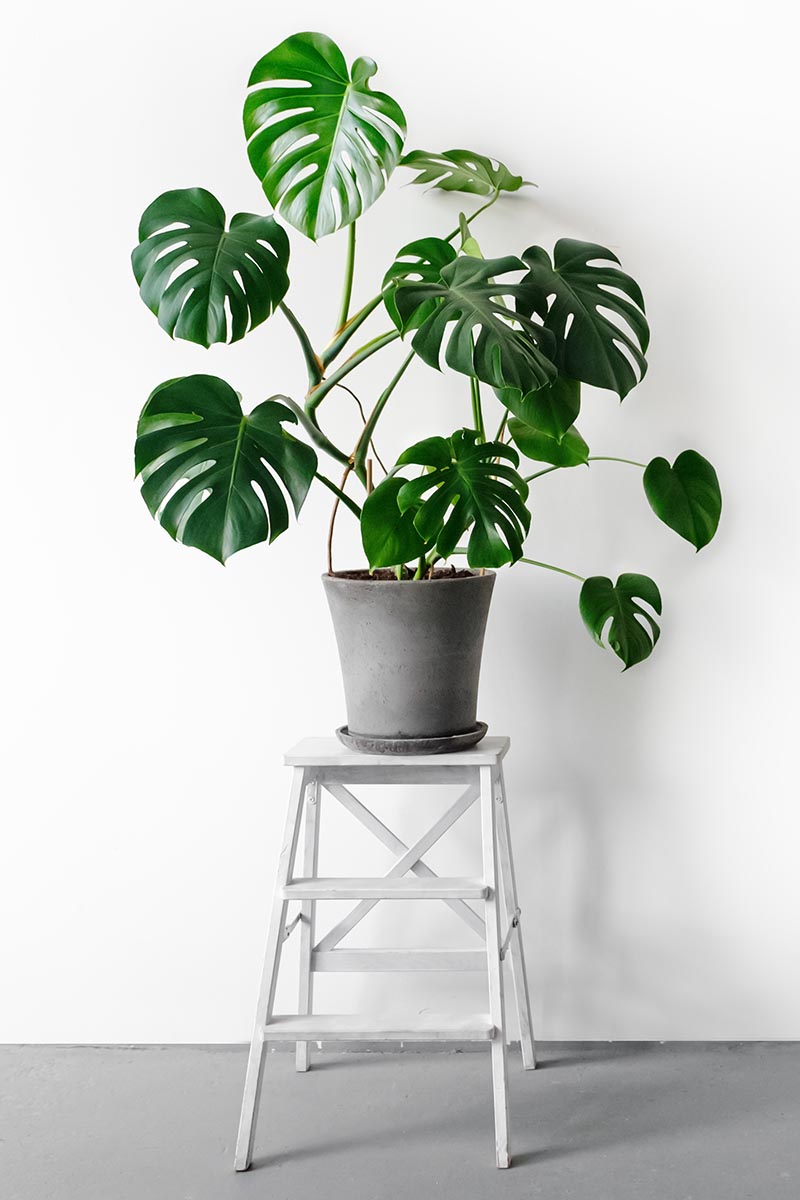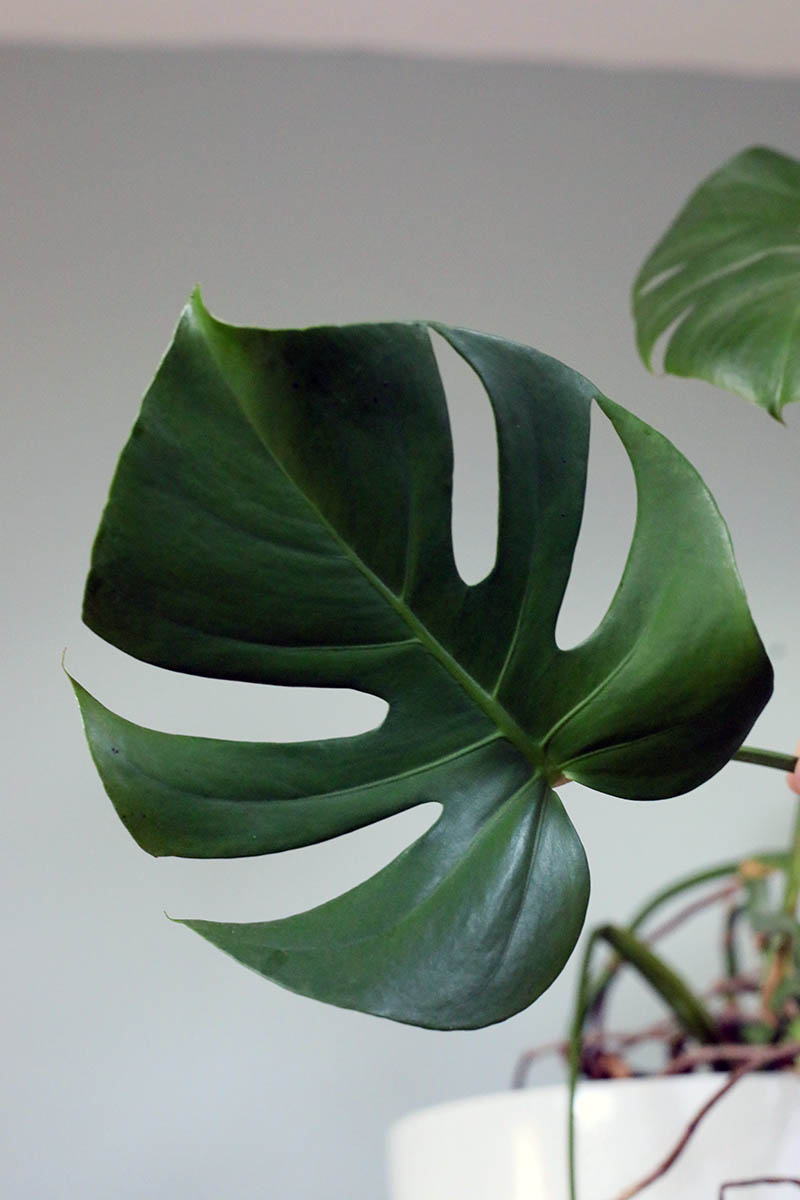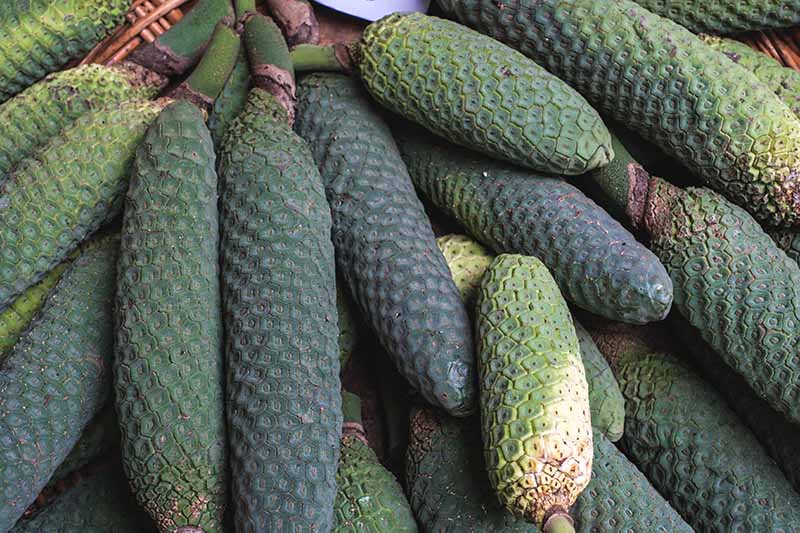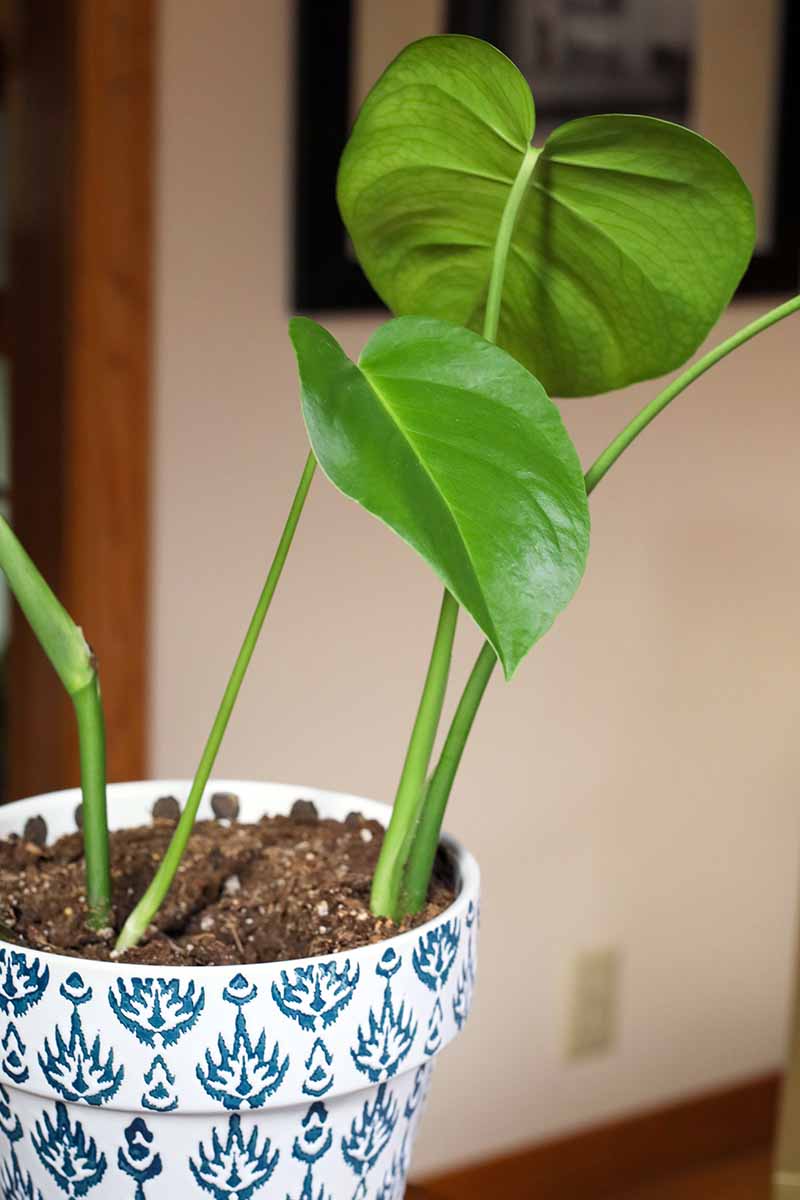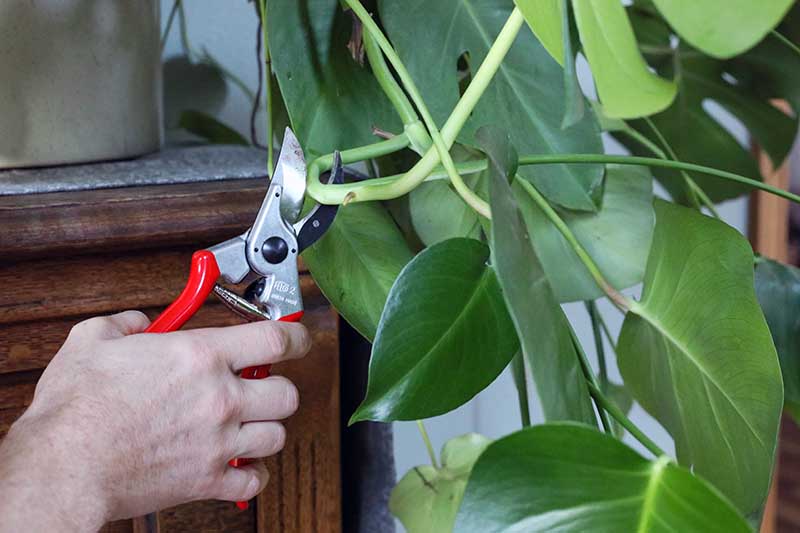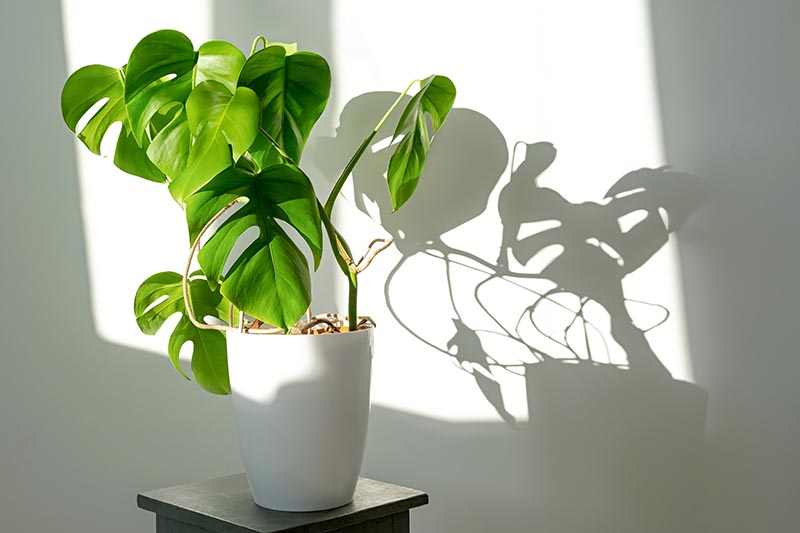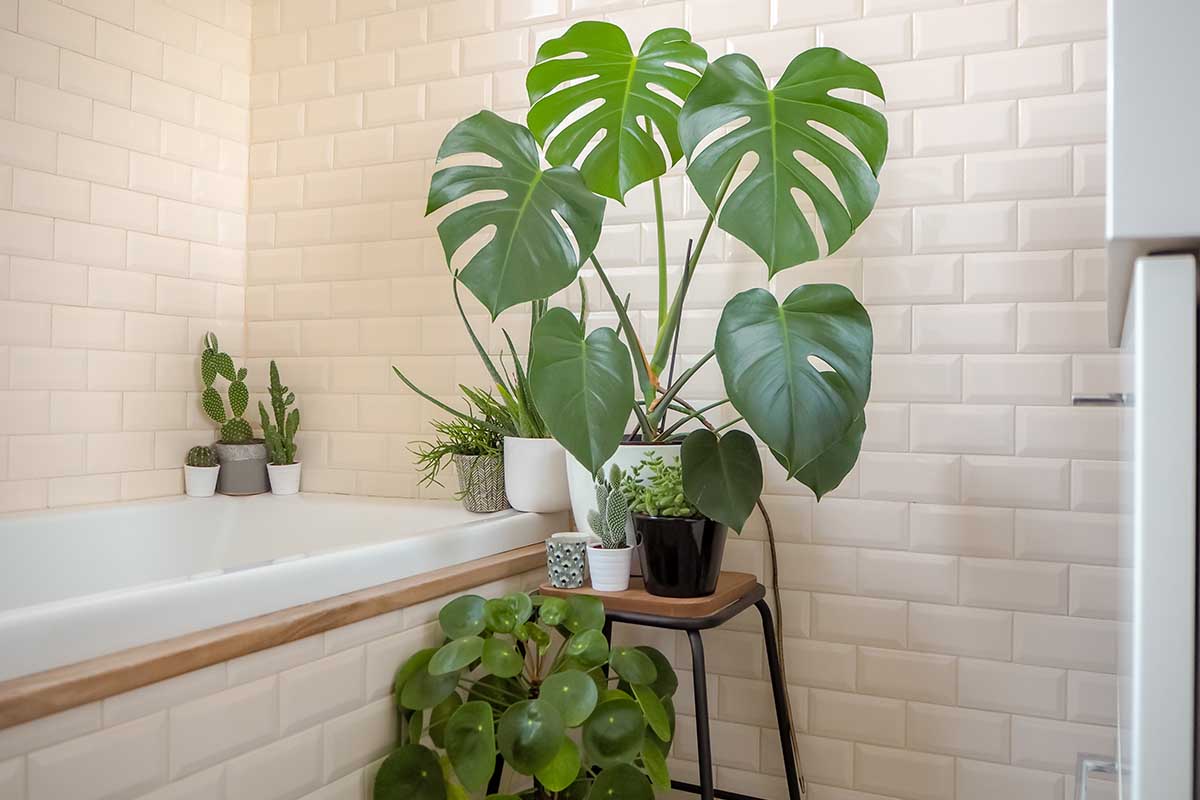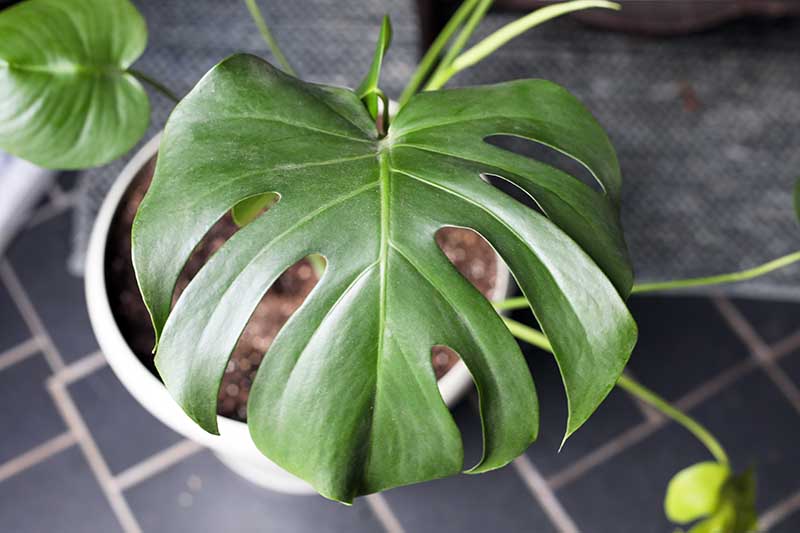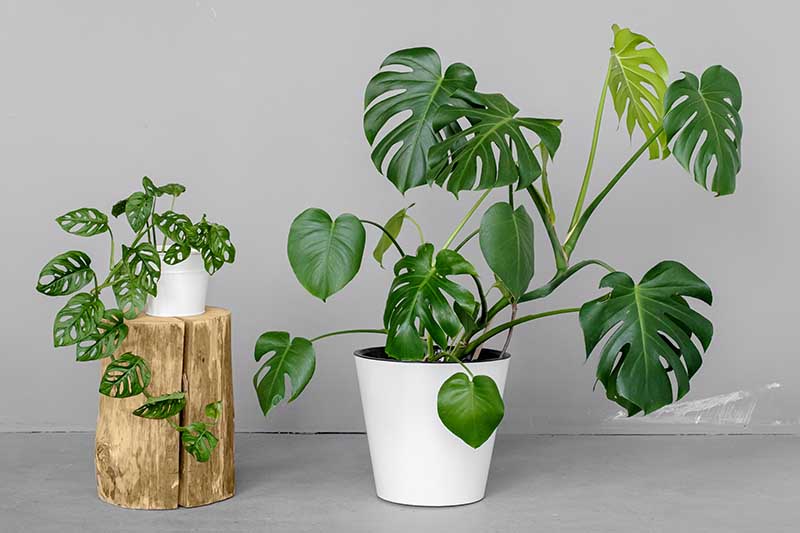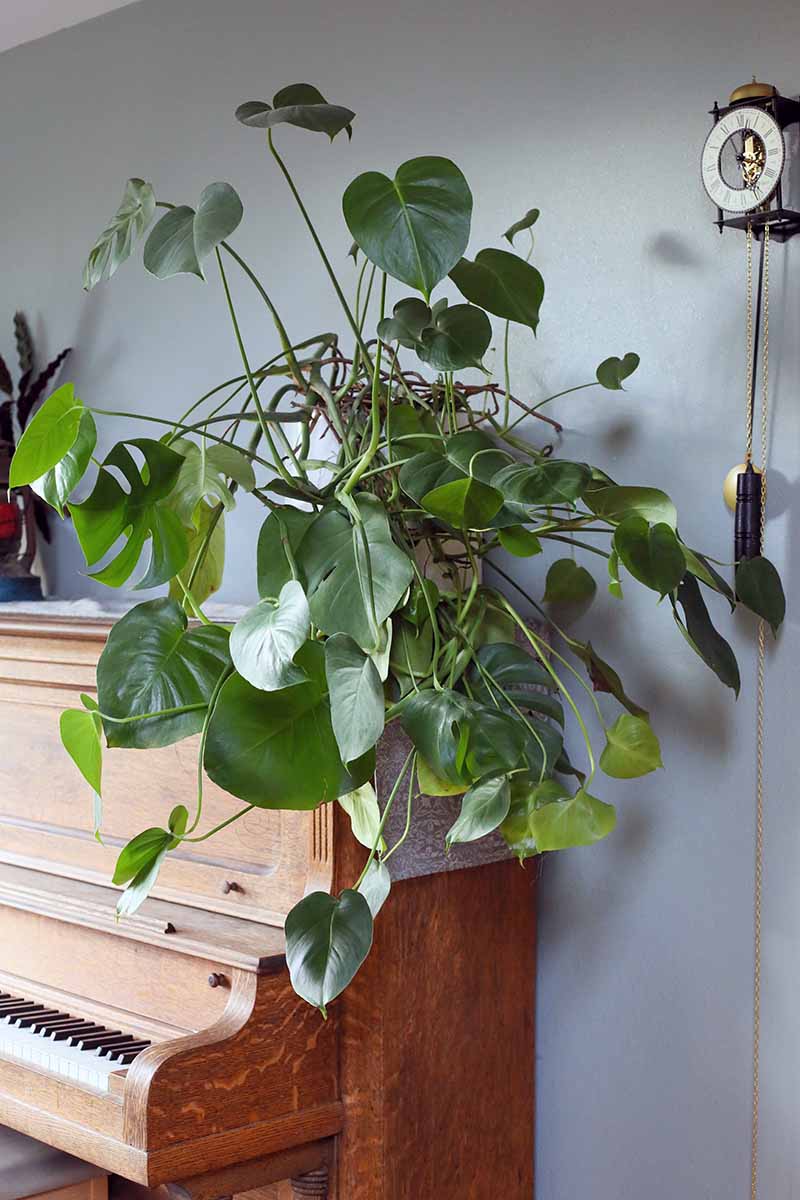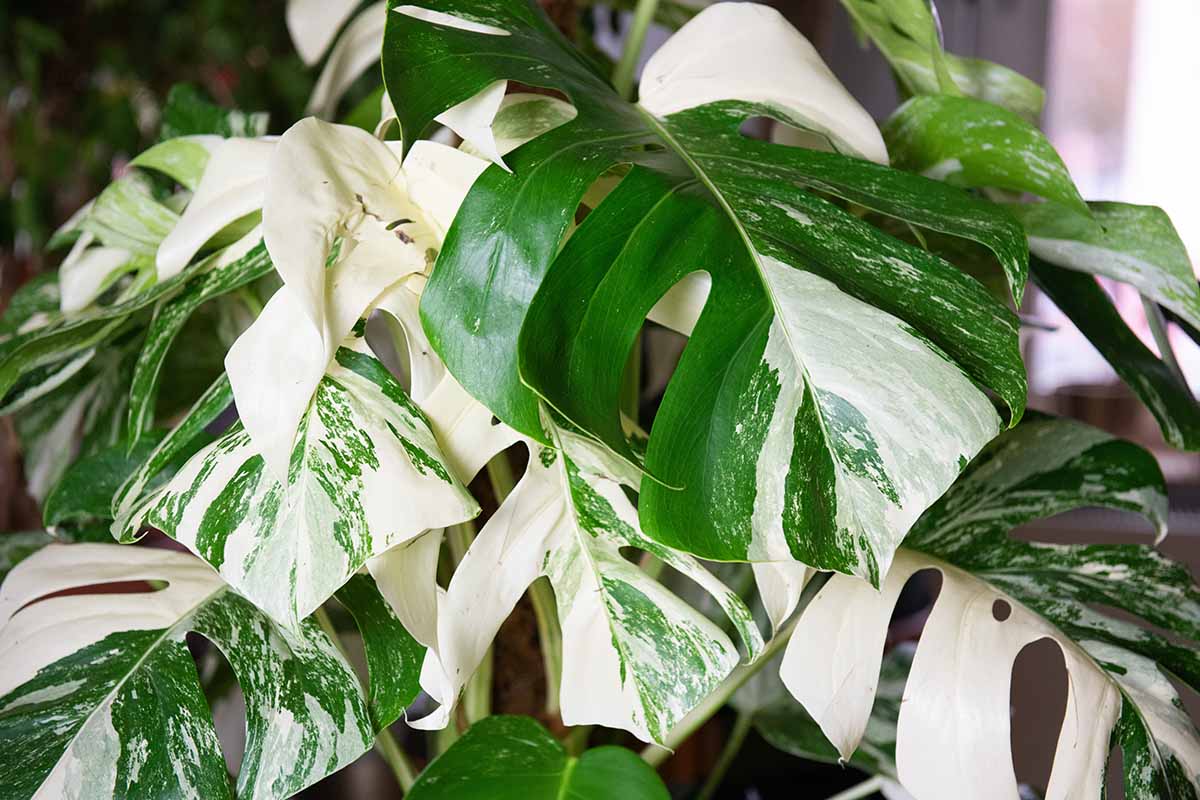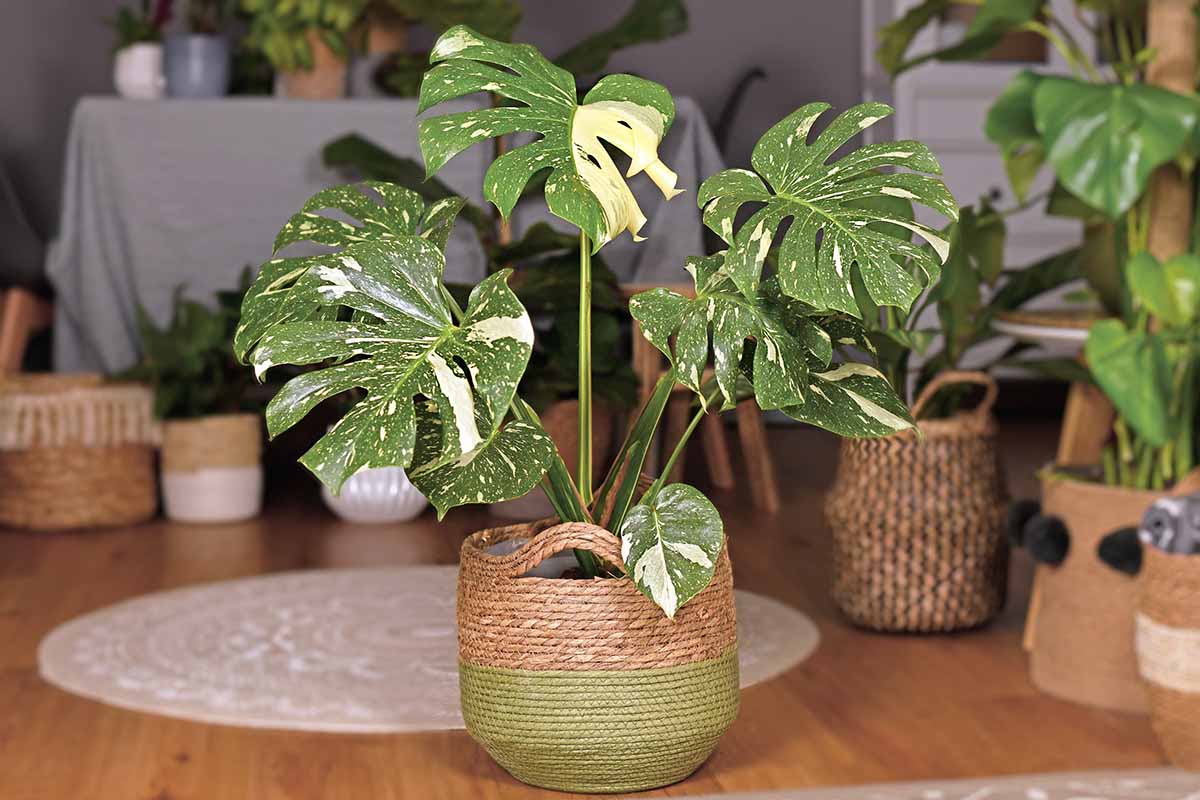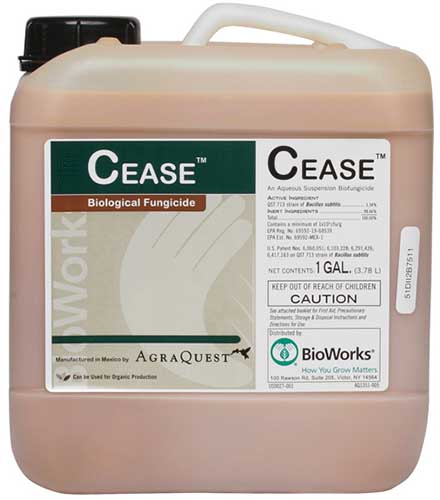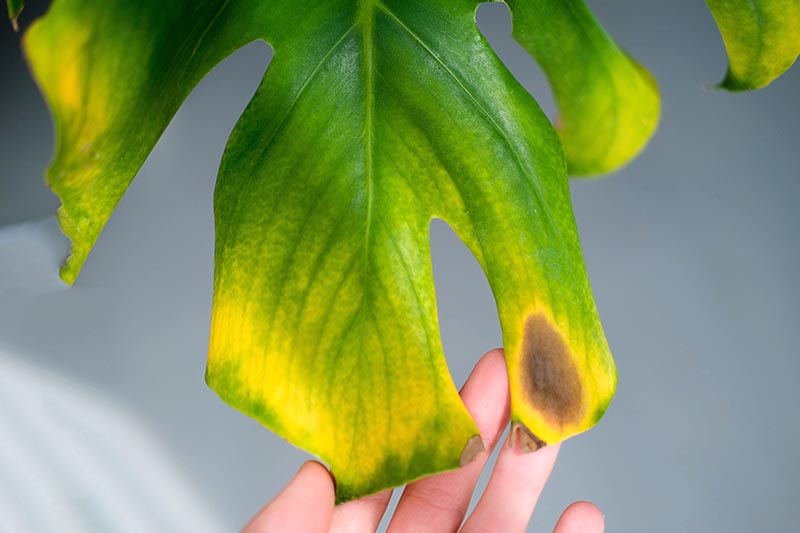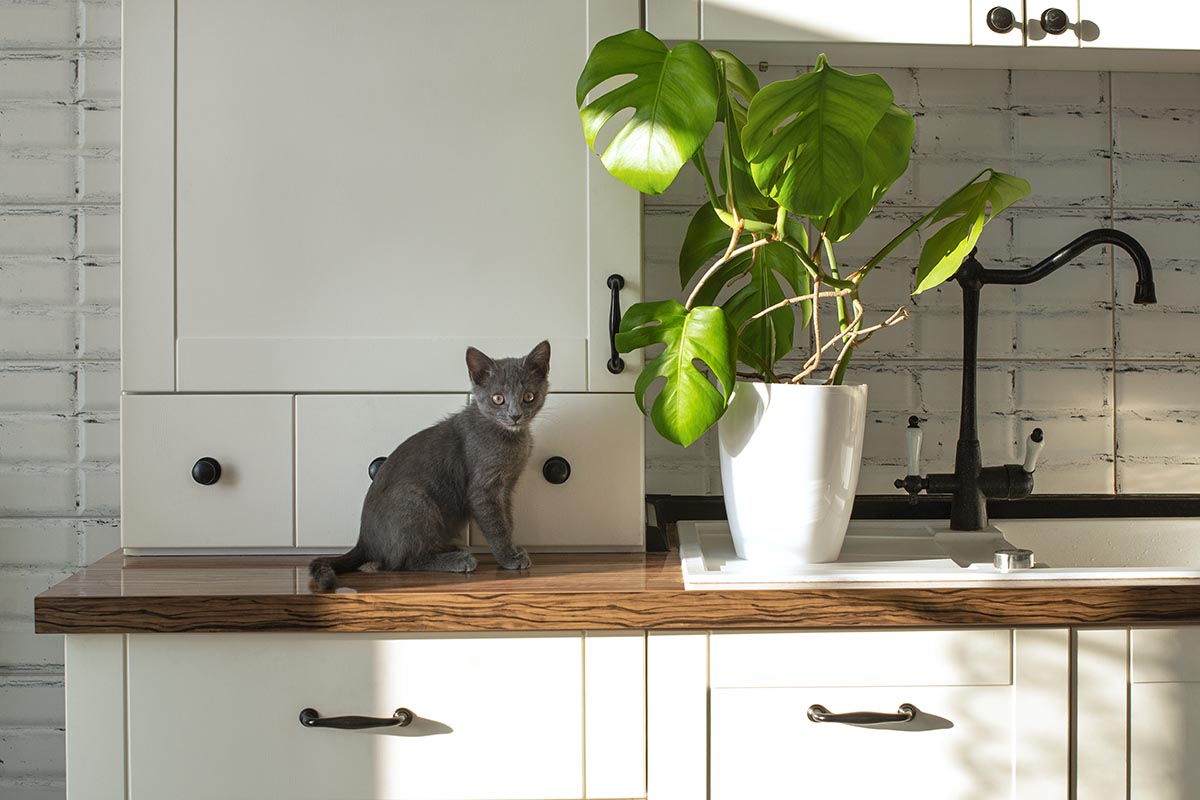Those big, holey leaves are show-stopping, without a doubt, but this is also a plant that is easy to care for. It won’t start tossing its leaves to the ground in a huff if it doesn’t get the exact perfect amount of sun, humidity, or water. We link to vendors to help you find relevant products. If you buy from one of our links, we may earn a commission. We’re going to go over everything a Swiss cheese plant lover needs to know to raise, propagate, and care for these distinctive houseplants. Here’s what we’ll cover: If you are as excited as I am about this iconic green wonder, then let’s start our journey!
Cultivation and History
The scientific name of this popular houseplant is Monstera deliciosa. Huh? Delicious monster? Basically, yes. Deliciosa refers to the edible fruit (which rarely shows up on those grown indoors), while Monstera probably means monster or monstrous in reference to the massive leaves, each one of which can potentially grow three feet long. So why “Swiss cheese plant”? That’s because of the holes that form in the leaves. The technical term for this growth is fenestration. The Latin word “fenestrare” means an opening for light, so you can see where this term comes from. Architects use this term, too, to describe openings in the envelope of a building. But I digress… As you can imagine, wide, long leaves can form quite the umbrella, or parasol, over the soil. Fenestrated leaves develop on certain plants so wind can move more easily through them, or so that light can filter through them like windows, as the name for this phenomenon implies. Other plants have fenestration so that water can fall through the holes to reach the roots. So, why do monsteras form their holes? The current theory as to why Swiss cheese plants fenestrate is to allow more light to be captured. In the American Naturalist Vol. 181 No. 2, Professor Christopher D. Muir of the Department of Biology at Indiana University argues that fenestration maximizes the plant’s chance of catching sunlight as it filters through the canopy of the forests where it grows. As you have probably gathered, monsteras grow beneath trees. They are semi-epiphytic, sending out both ground and aerial roots as they vine up taller plants. Members of the Araceae family, which also includes calla lilies and peace lilies, these plants are also often called split-leaf philodendrons. But while they are related to those oh-so-familiar houseplants, and part of the same family, they aren’t technically philodendrons. In Victorian England, the plant was cultivated in hothouses for the fruit, which tastes something like what you’d get if a banana and a pineapple made a delicious baby. The fruit is one of the reasons that people were interested in cultivating this beauty originally, though it’s obviously much more popular as a houseplant these days. Known as Mexican breadfruit, it’s tasty stuff, so if you have a chance to try it, don’t pass it up. Native to tropical areas of the North American continent from Mexico to Panama, it’s hardy in USDA Zones 10 to 12, and does well indoors if given a good amount of indirect light. It has been introduced to some tropical areas around the world, and has even started to become invasive in some places. Notably, though they prefer a good amount of light, monsteras are distinct from many other plants because they exhibit negative phototropism. This means at some points in their lives, particularly when they are young, they grow away from the light rather than towards it. In the wild, they can grow to be really, really big – we’re talking up to 70 feet tall. But don’t worry, in your house they’ll probably top out at about eight feet tall and six feet wide, assuming you give them something to climb.
Propagation
Swiss cheese plants are one of the easiest species to propagate that I have ever come across. If you want to feel like a real plant parenting professional, this is an excellent option to start with. Find more propagation tips here.
From Seed
It is possible to grow Swiss cheese plants from seed, but there’s a catch: You absolutely must find a reliable source. A quick internet search will reveal tons of “rare” and unique M. deliciosa seeds for sale, but you can’t always be sure of what you’re getting. Some reviewers that I noted say their “monstera” seeds grew up to be basil! It’s best to find a specialty retailer that you can trust. Besides ensuring positive identification of healthy seeds of the variety that you are actually hoping to grow, that’s because the seeds also need to be extremely fresh in order to germinate. It’s best if they are shipped fresh in moist sphagnum moss or a box that can keep them cool. Better yet, find someone with fresh fruits, slice them open, and pry out the fresh seeds. You can store the seeds in a sealed container in the fridge for up to a week if you can’t sow them right away. When it’s time to sow the seeds, fill a four-inch or larger container with a seed starting medium. Insert a single seed into the mix half an inch deep. Moisten the soil and keep it moist, like a well wrung-out sponge. Place the container in a spot with lots of bright, indirect light. In two to three weeks, a little green stem should poke out of the soil. This will eventually unfurl into a leaf. Now you can transplant your new seedling, as described below.
From Cuttings
This is the easiest plant I have ever propagated by taking cuttings. It’s so easy, in fact, that I figured out how to do it accidentally. I like to snip a few of the leaves from my main plant to put in a vase and display on my dining table. The first time I did this, when I went to toss out the leaves to replace them with some new ones, I noticed that the existing leaves had grown long roots. I hadn’t changed the water in weeks (I know, I was traveling…) and the leaves weren’t receiving much light, but there they were: healthy roots. I figured, why not try planting them in some soil to see if they would grow? And sure enough, within a few weeks, I had a thriving plant. I’ve done this dozens of times since then, and each time I’m as lazy as the first. Even still, my house is overflowing with Swiss cheese plants, and I give them away to friends too. If you want, you can use my lazy method, or you can go the more technically appropriate route. This involves cutting a leaf with a node attached and planting it in soil. The node is the bit where the stalk (petiole) meets the stem of the parent plant. If you see multiple leaves emerging from one spot, that’s a node. If you cut above this, you won’t be able to grow roots – whether in soil or water. Cut a few inches below a node, and you’ll be good. Insert the cutting into a soilless potting medium meant for starting seeds. Keep the medium moist but not wet, and place the cutting where it will receive lots of indirect sunlight. Six hours or more is ideal. Eventually, you should see new leaves starting to develop at the base of the plant. This can take a few weeks. When this happens, it’s time to transplant the seedling into a permanent pot, or outdoors.
Air Layering
Air layering takes a bit more work, but it is just as reliable as the cutting method. You need a slightly older plant that has a thick, hard stem. This doesn’t work on young, flexible stems. Make an incision about a quarter of the way through the stem that’s about an inch long. This should be right near a node. If you can do all this near an aerial root, all the better. Wrap the cut, and the aerial root if there is one, in moistened sphagnum moss. Seal it up loosely with some plastic wrap or a plastic baggie that you’ve cut open so it lays flat. Tape the bottom, and use a twist tie to secure the top. Every couple of days, open the top and make sure the moss is wet. Give it a good spray of water if it’s drying out, from a spritz bottle. After a few weeks, you should see a ton of new roots forming inside the plastic. At this point, you can remove the plastic and moss, and sever the stem from the rest of the plant using a pair of clean secateurs. Plant this as you would a transplant. Before you move your new monstera, prep the container first. Fill the bottom of the container with a bit of all-purpose potting soil. There should be enough at the base that the plant will sit at the same height that it was before. You can even pick one up in a nine-inch container at Fast Growing Trees in a three-gallon pot. Your plant even comes with a one year warranty on the off chance that you manage to (accidentally!) kill it. Monstera deliciosa If you decide to buy a started plant, you can leave it in the container it came in (assuming it has drainage holes, a quality potting medium, and isn’t pot-bound) or you can transplant it into a new container. Squeeze the sides of the plastic container that the plant came in and gently tug the whole thing out by the stem. Gently loosen the roots and knock away some of the soil. The goal is to encourage the plant to spread out, and to remove old soil so you can replace it with fresh stuff. Place it in the prepared container and fill it in with potting soil. Give it a good soak.
How to Grow
You have to love a plant that doesn’t make a lot of demands on your time. Swiss cheese plants are like that. They’re cool if you want to just leave them be for a while. They don’t need to be constantly moist. Just water when the top inch or two of soil dries out. They’ll do fine in a bit of shade, though they’re happiest in bright, indirect light. Alternatively, you can place them somewhere that they will receive direct sunlight for a few hours a day. However, you will need to transition them to the sunnier spot over a series of weeks by gradually allowing them to receive more light each day in increments of 15 minutes or so until they are sitting in direct sun for up to four hours per day. You can increase the humidity near the plant by grouping it with other plants or using a humidifier. These plants prefer humidity above 40 percent. But don’t stress over it, though – other plants might drop leaves or turn brown if they are too dry, but unless your air is seriously dry, your monstera will be fine. So long as you keep your house at an average temperature somewhere between 60 and 80°F, your monstera will be happy. Watch out if things drop below 50°F. (If that happens, you might also want to check your pipes for freezing!)
Encourage Fenestration
Many gardeners love the heavily fenestrated leaves of the Swiss cheese plant, and if you count yourself as one of those people, then you might want to learn how to encourage your plant to form those lovely holes. First, know that a young plant won’t typically fenestrate for its first few years. However, this doesn’t apply to plants formed by taking cuttings. I can tell you from firsthand experience that a cutting can start fenestration within just a few months. In fact, as I write this, a cutting that I planted six months ago is sitting next to me. It started out as one single solid leaf and now it has seven smallish leaves, three of which are heavily fenestrated. And despite some theories that only larger, fully mature leaves will fenestrate, two of the fenestrated leaves emerged with the holes already formed. Anyway, back to the point. It’s possible to encourage your plant to form deep slits and holes. Having said that, know that unless you trim away any solid leaves that you see, there will always be certain ones that don’t fenestrate. So, if you’re sure your plant is the right age, how do you encourage it to split? Give it plenty of sunlight and the right amount of water. If you don’t provide enough light and water, the plant won’t have the right conditions to develop the leaves you’re looking for.
Growing Tips
Water when the top inch of soil has dried out.Provide bright, indirect light.Ensure that you provide adequate water and light to encourage fenestration.
Maintenance
Your most difficult job when it comes to maintaining Swiss cheese plants is repotting, when necessary. These plants can grow to be extremely large and unruly, so you might need to enlist a friend to help. Remember that you need a container with good drainage, and once your plant starts sending out tons of aerial roots and touching the edges of the current pot, it’s time to go up a size. That said, you can constrict a monstera to encourage it to stay smaller. It will send out lots of aerial roots, but it will be perfectly fine. Just prune away some of the foliage to help constrain its growth. When you repot, remove the existing plant from its container. You might want to use a stock or narrow saw to loosen the root ball from the edge of the container. You can also wrap the leaves in a towel or blanket to help corral them. Then, prepare a new container with a bit of soil in the bottom so the crown will be sitting at the same level it was before. Knock away as much of the old soil as you can, and put the root ball in the new pot. Fill in around the roots with fresh potting soil. Be sure to wipe the leaves with a moist cloth now and then to remove any dust. This allows the leaves to breathe and access light. Finally, if you are growing variegated ‘Albo,’ be sure to remove any leaves that appear without variegation. The white coloring that this variety is known for occurs thanks to a genetic mutation, whereas the unique coloration of ‘Thai Constellation’ variegated plants grown from tissue culture is more stable.
Climbing
As your plant ages, you might want to give it something to climb. This is especially true if you decide to contain your plant rather than repotting it. After a plant matures, it can become quite floppy. But that’s not necessarily a bad thing, if you want to create a hanging or trailing look over a shelf. A pole covered in moss or coconut coir is ideal, though you can also use a trellis. Just know that this plant doesn’t twine itself in and out of structures. It uses its aerial roots to cling to things instead, so you’ll need to guide it through the holes to fill the trellis in if that’s the look you’re going for. A mossy pole also serves to recreate the environment that this plant evolved to survive in. Remember, it grows up mossy trunks in the wild. To encourage your Swiss cheese plant to climb, loosely tie the main stem to the pole or trellis. You don’t need to affix it firmly, just encourage the stem to grow upright near the pole. Then, as aerial roots emerge, either wrap them around the pole or loosely fasten them with twine. Once you give your monstera a climbing start, it will figure things out on its own, and will attach new roots to the pole.
Varieties to Select
Of the species deliciosa, there is a cultivar with variegated leaves, and that is the coveted ‘Variegata.’ This puppy is extremely expensive because it is fairly uncommon, but it’s easy to see why people will pay good money to get their hands on it. M. deliciosa There are several additional monstera species that are popular houseplants, of which M. adansonii is probably the most common. This one is often labeled as a Swiss cheese plant as well, but you can tell that it is a different species by its smaller leaves with holes that are more narrow than those of M. deliciosa. Monstera adansonii If this pretty alternative appeals to you, Fast Growing Trees carries it in three-gallon containers. Less often, you’ll see M. pinnatipartita, which has large leaves with heavy fenestration that extends from the edges of the leaves to the midrib, giving them an almost fern-like appearance. Picture the Swiss cheese plant’s massive, fenestrated leaves and add patches of marbling in light green, creamy yellow, and off-white. Some leaves might even have one side that is creamy white, or they might be entirely that color. It’s extremely striking. There are a couple of other variegated cultivars out there as well, including ‘Albo Variegata,’ which has chunky near-white patches and pure-white leaves. Often referred to simply as ‘Albo,’ it’s fussy and needs carefully maintained conditions since those distinct light patches are expressed because the plant produces less chlorophyll than its solid counterparts. It’s also prone to sunscald, so don’t place any variegated varieties in direct sunlight. And it is more susceptible to disease as well. You might also see ‘Thai Constellation,’ which has white speckles rather than patches. Again, it’s more challenging to care for than a solid monstera, but not as finicky as ‘Albo.’ Both sell for a pretty penny, so be prepared to open your wallet.
Managing Pests and Disease
Monsteras are sturdy. They aren’t delicate and in need of pampering to stay healthy (okay, except for the rare ‘Albo’ cultivar). But no matter how diligent you are or how hardy the plant is, occasional pest infestations and infections are possible. Should you run into trouble, here’s how to cope.
Insects
In my experience, pests are the problem on houseplants more often than diseases. You should become familiar with the following insects, because they’re extremely common. Having no natural predators indoors, these insects can reproduce rapidly.
Aphids
Where there are plants, there are aphids. It’s just a matter of when, not if, you will be visited by them. That said, unless you have a very young Swiss cheese plant, it’s unlikely that these pests will cause much trouble. The waxy coating on the leaves and stems makes them unattractive to these common sapsuckers. Signs of an infestation include yellowing and drooping leaves. Examine your plant and look for tiny pear-shaped insects that are green, yellow, brown, orange, or peach. They may or may not have wings. To control them, place the plant in a shower or tub, and spray the foliage and stems with water to knock the bugs loose. You might have to do this once a week for a few weeks. If that’s not working, break out the neem oil or insecticidal soap. You’ll need to spray your plant with it once every week or two, as long as the pests are present.
Scale
Scale is common on indoor plants. These small sap-suckers can look a lot more like a sign of disease than pests, but they are in fact insects. The most common species on indoor plants is brown scale (Coccus hesperidum). These are flat and brown, and you need to look extremely close to see their heads or legs. They like to cluster on the stems and will sometimes venture onto the leaf surfaces. When they infest a plant, you’ll see leaf yellowing and stunted growth. New foliage will be slow to emerge. It won’t fenestrate, and it won’t grow as large as it should. On the bright side, if you are the patient sort, this is a fairly easy problem to remedy. Isolate your plant and grab a bunch of cotton swabs and some rubbing alcohol. Dip the swabs and rub the alcohol onto the carapaces of the scale. You’ll have to keep at this, but eventually, you can wipe out an infestation. If you have a bigger problem than cotton swabs can address, trim away the worst of the infested leaves and stems and dispose of them. Then, spray weekly with insecticidal soap until there’s no more evidence of infestation. Learn more about scale in our guide.
Spider Mites
There are many different species of spider mites, but red spider mites (Tetranychus urticae) are the ones that love to hang out on houseplants. They’re itty-bitty, so it’s unlikely that you’ll know they’re there until you spot fine webbing on your poor plant. When you see webbing, it’s time to act. Spider mites are fairly wimpy when it comes to moisture. If you water your plant well and keep the area humid, visits by these pests aren’t common. Upping the frequency of your watering routine and increasing humidity are also excellent ways to eliminate them. You can also rinse them off, as you would do with aphids. If none of that works to remedy the situation in your circumstances, break out the insecticidal soap.
Disease
Diseases aren’t at all common (you aren’t growing ‘Albo’… right?), but you can’t rule out the possibility of infection entirely. Be prepared to deal with the following, just in case:
Anthracnose
Caused by fungal species in the Colletotrichum genus, this disease causes the leaves to start to yellow on the margins before turning entirely yellow and dying. You might also see yellow coloring or lesions on the stems. Your best bet at achieving control is to take a multi-pronged approach. First, be sure to water at the base of the plant, not on the foliage. Reduce watering a bit until the problem is gone. At the same time, use a copper spray designed for use on indoor plants. Apply it according to the manufacturer’s directions, spraying once a week or every 10 days.
Bacterial Leaf Spot
A lot of people are surprised to learn that plants can be impacted by viral and bacterial pathogens, just like humans and other animals can. If you decide to go this route, apply the beneficial bacteria twice a week by spraying the leaves and stems thoroughly. CEASE Biofungicide Pick up some CEASE, which contains B. subtilis, at Arbico Organics in one- or 2.5-gallon containers. That might sound like a lot for treating just one houseplant, but you can also use it outdoors on veggies or ornamentals, and it doesn’t kill beneficial insects such as bees. It also is effective against a bunch of annoying fungal issues. Bacterial leaf spot is caused by a wide range of bacterial species, but these are usually in the Pseudomonas or Xanthomonas genera. It typically appears as small brown leaf spots. These spots differ from those caused by overwatering because they appear in small clusters at the center of the leaf. Sadly, there isn’t an effective treatment available. But if you are diligent about pruning away any symptomatic leaves, you can generally eliminate it.
Root or Stem Rot
Rotting roots or stems can be caused by two things: overwatering, and fungi. The first drowns the roots, depriving them of oxygen, and essentially smothering the plant to death. Gruesome. It’s easier for this to happen than you might realize, because monstera roots like to have access to plenty of air, and they don’t take well to being smothered. The second is caused by fungi in the Pythium, Rhizoctonia, or Fusarium genera. Regardless, both problems look the same. You’ll start to see dark spots on the margins of the leaves. These spots grow larger until the entire exterior of the leaf is a sad brown and yellow color. After that, the leaves die, and the entire plant can even die if a case of rot is severe. Since it’s impossible for home gardeners to tell which variety your plant is suffering from, you need to treat both problems at once. First, trim away any impacted leaves. Pull your plant from its pot. Brush or wash away as much soil from the roots as you can. Then, spray the roots with a product containing Bacillus subtilis. As I mentioned above, CEASE is a good option. Sanitize the container with a 10 percent bleach solution (one part bleach to nine parts water) after rinsing out any soil and allow it to dry. Switch to a container with better drainage if you need to. Repot your plant with fresh soil. Spray the foliage with the same product you used on the roots, once every other week for two months. Going forward, water less often than you were watering before. Check the soil with your finger or use a moisture meter to be sure that you’re not overwatering. On the rare chance that you run into trouble, don’t hesitate to come back and let us know in the comments what problems you’re experiencing. Hopefully we can help! If you want to add some more houseplant buddies to your plant menagerie, read these articles next:
How to Grow and Care for Rubber TreesHow to Grow and Care for SpiderwortHow to Grow and Care for Dracaena

